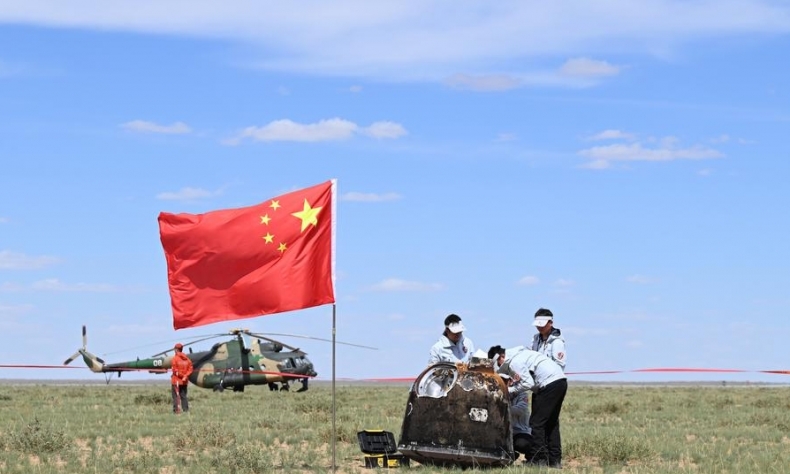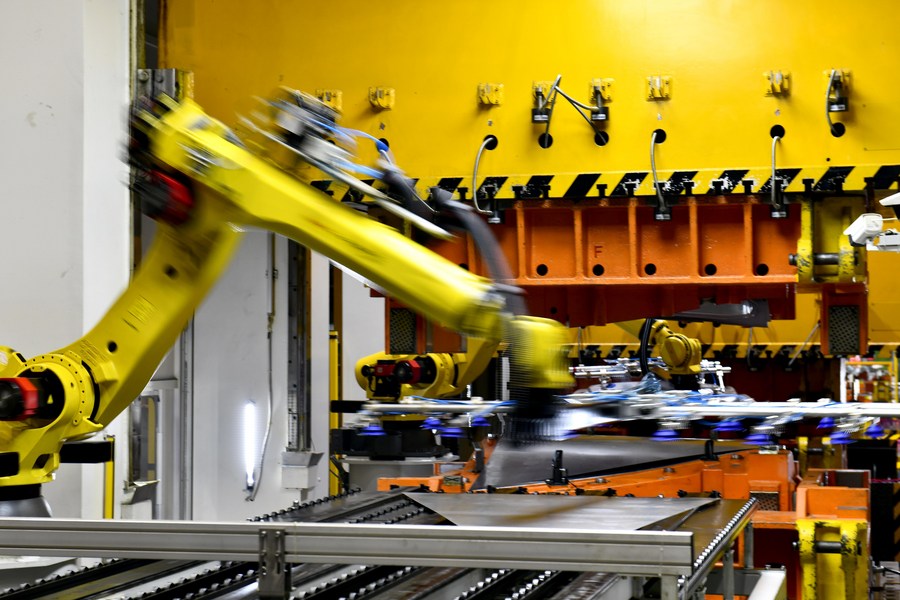Aiming Far Beyond the Moon

The recent plenum focused on deepening reform placing science and technology at the heart of the high-quality development that China intends to achieve.
Chang’e is the Chinese moon goddess. Named after her, the Chang’e-6 lunar module returned to earth this June carrying 1,935.3 grams of rocks and dust from the far side of the moon.
A world first, the unique samples, more viscous and clumpier than previous lunar specimens, will be distributed worldwide for scientific analysis.
China’s lunar program began as recently as 2007 when Chang’e-1 was placed in orbit to create a high resolution 3-D map of the moon’s surface. As such, it illustrates China’s enviable ability to concentrate its efforts on major tasks. This ability, President Xi Jinping has suggested, is one of the major advantages of China’s socialist system.
The results of China’s capacity to concentrate on major tasks are equally evident in its rapid transition from a rural economy to a global industrial power, in the successful elimination of extreme poverty, in building the world’s largest high speed train system and in pursuing a fast transition to green energy.
It is apparent, too, in the transformation of China into a leading scientific nation. As recently as 2019, the London-based The Economist asked whether China could become a scientific superpower. In June, this year, it concluded that: “Today, that question has been unequivocally answered: ‘yes.'”
This bodes well for China as the world confronts an information revolution as important as the invention of the printing press (which China devised and Uyghur people may have taken West along the Silk Road). Printing energized the Western Renaissance, facilitated the industrial and scientific revolutions and helped legitimate secularism. Artificial intelligence, quantum computing, biotechnology and, alongside these developments, the transition to a post-carbon economy are likely to be equally transformative.
This is why the recently held third plenum of the 20th CPC Central Committee is so important. The Central Committee, elected by the quinquennial National Congress, is after the Congress, the Party’s top decision-making body. Its plenary meetings, held seven times every five years since the 18th CPC National Congress, are usually called plenums. This year, the third plenum introduces major policy initiatives with an eye on the future.

Many third plenums have become waypoints delineating China’s progress and relationship with the world. The 1978 plenum laid the foundations for the “reform and opening-up policy.” The plenum in 1993 announced the liberalization of the yuan while emphasizing a socialist market economy. Those in 1998 and 2008 focused on agriculture and consequently contributed to the eradication of rural poverty and to establishing China as the world leader in agricultural science. The 2013 plenum introduced the strategy of comprehensively deepening reform while also ending the one-child population policy.
The recent plenum focused on deepening reform placing science and technology at the heart of the high-quality development that China intends to achieve. As the official communique stated: “We must fully implement the strategy of invigorating China through science and education, the strategy of developing a quality workforce, and the innovation-driven development strategy, make coordinated efforts to promote integrated reform of institutions and mechanisms pertaining to education, science and technology, and human resources, and improve the new system for mobilizing resources nationwide to make key technological breakthroughs.”
It is noteworthy that China has scientists at the center of government with five of the 11 newcomers elected to the Political Bureau of the CPC Central Committee in 2022 being eminent scientists.
Among them are Ma Xingrui and Yuan Jiajun, respectively chief commander of the Chang’e-3 program that successfully placed a lander on the moon in 2010, still operational today, and chief commander of the Shenzhou Spacecraft, China’s National Manned Space Program. Both scientists hold executive positions that enable science directly to inform policy decisions; Ma and Yuan are respectively the top CPC officials in Xinjiang Uygur Autonomous Region and Chongqing, China’s most populous city.
The Central Science and Technology Commission, established in 2023, promotes science-based innovation as the driving force of China’s new development model. Headed by Vice Premier Ding Xuexiang, an engineer, it ensures that the efforts of ministries, research institutes and industry are focused on the major task on transforming scientific excellence into practical applications.
Exploiting its lead in frontier technologies and the digital economy, China can successfully transition to become a high-income country, avoiding the ‘middle income trap’ that has prevented further development in many other countries. Equally, science-led, high-quality development must be sustainable, low carbon and green. This will need to be encouraged by innovative fiscal, investment, and pricing regimes and by enhanced ecological protection compensation schemes. To adopt the poetic language of the plenum communique, “We must improve ecological conservation systems, make concerted efforts to cut carbon emissions, reduce pollution, pursue green development, and boost economic growth, actively respond to climate change, and move faster to improve the systems and mechanisms for applying the principle that lucid waters and lush mountains are invaluable assets.”
China intends to avoid mistakes made by other countries that have hollowed out traditional industries. Around 30 percent of global manufacturing output is currently contributed by China which leads the world in two fifths of the major categories of industrial products. It is imperative, therefore, for enterprises in these sectors either to adopt advanced technologies to remain competitive, or to transform when upgrading proves impossible. China’s ability to facilitate such transitions rests on its unique ability to combine effective government with the efficient use of market forces.

China’s response to the new information revolution is not aided by those insistent on global leadership and fearful of fair competition. The U.S. has imposed export controls, financial sanctions and inbound and outbound investment screening that are “narrowly focused” on Chinese technology. Many of these actions are considered to be a violation of human rights because of their negative impact on the wellbeing of Chinese citizens. While openness fosters economic efficiency and global development, and science advances through international collaboration, this is not the American way.
In contrast, China’s “opening up” has always been seen as a two-way opportunity. Vice Premier Ding Xuexiang reiterated this when addressing the 2024 Zhongguancun Forum in April. China, he emphasized, was keen to work with others to put into action the principles of “open, fair, just and non-discriminatory” international cooperation in science and technology, fostering a global scientific community.
Similarly, the Plenum aspires to “steadily expand institutional opening up, deepen the foreign trade structural reform, further reform the management systems for inward and outward investment, improve planning for regional opening up, and refine the mechanisms for high-quality cooperation under the Belt and Road Initiative.”
While a lack of international cooperation would slow learning and hold back global development, informed commentators recognize that it could eventually to strengthen the Chinese economy. As recently as 2018, China needed to import 35 key technologies but, when threatened, these so-called “chokepoints” can be addressed. Seven times more STEM students graduate in China annually than in the U.S.A. and thousands of Chinese scientists working abroad could be welcomed home. As The Economist magazine noted, “Even Huawei has prospered despite foreign sanctions.”
Scientists might study science for science’s sake. However, the ultimate goal of China’s development and reform is to meet people’s aspirations for a better life. President Xi Jinping stressed this when speaking at a symposium of business leaders and academics in Jinan in Shandong Province in May. He drew attention to “the pressing concerns and aspirations of the general public” in relation to employment, income growth, education, healthcare, housing, government services, childcare, elderly care, personal safety, and property security.
These pressing concerns mean that action is required while the new information revolution is still unfolding. Development must generate more high-quality employment, create better entrepreneurial opportunities, be more inclusive and reduce regional and urban-rural disparities. New wealth produced through technological advance should be fairly distributed with better access to education and public health care, and more comprehensive social security. Those newly arriving in cities should be better integrated and rural dwellers permitted to share in China’s growing prosperity through economic revitalization and improved service provision.
The legacy of this year’s plenum may be its response to the pressing concerns identified by President Xi Jinping. It pledges to: “improve the institutions and mechanisms for advancing new urbanization, consolidate and improve the basic rural operation system, … improve the income distribution system, the employment-first policy, and the social security system, further reform the medical and healthcare systems, and improve the systems for facilitating population development and providing related services.”
Science and technological development thus become means to a greater goal. Reaching the moon is merely a step towards achieving common prosperity.
 Facebook
Facebook
 Twitter
Twitter
 Linkedin
Linkedin
 Google +
Google +







